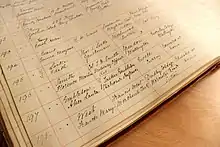Alice Laura Embleton
Alice Laura Embleton (1876-1960) a été l'une des premières femmes à étudier les sciences à l'University College of South Wales and Monmouthshire, et parmi le premier groupe de femmes à être nommée fellow de la Linnean Society of London en 1905. Biologiste et zoologiste, Alice Embleton a conduit des recherches sur les pesticides pour améliorer la production agricole. Elle fut une suffragette notoire.
| Naissance | |
|---|---|
| Décès | |
| Nationalité | |
| Formation |
Sutton High School (en) |
| Activités |
Pendant de nombreuses années, elle a eu une relation avec la scientifique Celia Wray.
Biographie

Alice Embleton est née à Epsom, Surrey et a fréquenté la Sutton High School, London (en). Elle s'est inscrite à l'University College of South Wales and Monmouthshire, maintenant Cardiff University, en 1895, et a obtenu en 1899 un Bachelor of Science[1].
En 1900, elle a remporté la 1851 Research Fellowship (en), qui attribue chaque année une bourse de recherche de trois ans à « de jeunes scientifiques ou ingénieurs exceptionnellement prometteurs »[2]. Elle a utilisé la bourse de 150 £ pour travailler au Laboratoire biologique Balfour à Newnham College, Cambridge, suivi d'une nouvelle période d'études à la Sorbonne à Paris[3]. Elle est considérée comme la deuxième femme à publier sur le sujet de la copépodologie (en), après Edith Mary Pratt[4].
En 1903, elle a été nommée zoologiste honoraire au Board of Agriculture et a remporté la bourse Mackinnon de la Royal Society pour la recherche en sciences biologiques[5].
Elle a été l'une des premières femmes à prendre la parole à la Linnean Society, Burlington House, Londres[6]. Son article, publié le 4 juin 1903, était intitulé : « Anatomy and Development of a Hymeropterous Parasite of a Scaly Insect (Lecanium Hemisphoericum) »[7]. Parmi quinze autres femmes, elle a été nommée membre de la Linnean Society en 1905[8]. Les archives de la Linnean Society contiennent la correspondance d'Embleton avec la Society, dont elle est restée membre jusqu'en 1917[9].
En 1906, elle a co-publié les articles, On the synapsis in amphibia[10] et On the origin of the sertoli[11].
Plus tard, elle a mené des recherches sur le cancer au Royal College of Science (en) de South Kensington[12] - [13].
Publications
- On the Economic Importance of the Parasires of Coccidae, Entomological Society of London, 1902
Bibliographie
- Emily Hamer, Britannia's Glory: A History of Twentieth Century Lesbians, Bloomsbury Publishing, 2016, p. 56-57
- Charles Griffin, Quarterly Journal of Experimental Physiology, vol. 2 à 3, 1909, p. 192
- Transactions of the Highland and Agricultural Society of Scotland, Royal Highland and Agricultural Society of Scotland, W. Blackwood & Sons, 1905, p. 213
- The Annals and Magazine of Natural History, vol. 1, Taylor & Francis, 1928, p. 199
- David Sharp, Fauna Hawaiiensis: Being the Land-fauna of the Hawaiian Islands, vol. 3, The University Press, 1913, p. 180
- Charles Griffin, Quarterly Journal of Experimental Physiology and Cognate Medical Sciences, 1909, p. 191-192
Références
- (en) Cet article est partiellement ou en totalité issu de l’article de Wikipédia en anglais intitulé « Alice Laura Embleton » (voir la liste des auteurs).
- (en) Sue James, « In search of a scientist – and a suffragist? », sur Special Collections and Archives / Casgliadau Arbennig ac Archifau, (consulté le )
- (en) « Royal Commission for the Exposition 1851 », sur royalcommission1851 (consulté le )
- (en) « CARDIFF COLLEGE I 1909-03-18 Evening Express - Journaux gallois », sur newspapers. library.wales (consulté le )
- (en) David M. Damkaer, The Copepodologist's Cabinet: A Biographical and Bibliographical History, American Philosophical Society, (ISBN 978-0-87169-240-5, lire en ligne)
- (en) « GIFTS TO CARDIFF COLLEGE. I 1903-10-10 The Cardiff Times - Welsh Newspapers », sur newspapers.library.wales (consulté le )
- (en) « EDITORIAL NOTES.|1903-06-26|The Cambrian News and Merionethshire Standard - Welsh Newspapers », sur newspapers.library.wales (consulté le )
- (en) Alice L. Embleton, « V. On the Anatomy and Development of Comys infelix, Embleton, a Hymenopterous Parasite of Lecanium hemisphæricum. », Transactions of the Linnean Society of London. 2nd Series: Zoology, vol. 9, no 5, , p. 231–254 (ISSN 1945-9343, DOI 10.1111/j.1096-3642.1904.tb00449.x, lire en ligne)
- Linnean Society of London (University of Illinois Urbana-Champaign), Proceedings of the Linnean Society of London, London, Published for the Linnean Society of London by Academic Press [etc.], (lire en ligne)
- (en-GB) « Archives », sur The Linnean Society (consulté le )
- J. E. S. Moore, A. L. Embleton et John Bretland Farmer, « On the synapsis in amphibia », Proceedings of the Royal Society of London. Series B, Containing Papers of a Biological Character, vol. 77, no 521, , p. 555–562 (DOI 10.1098/rspb.1906.0043
 , Bibcode 1906RSPSB..77..555M)
, Bibcode 1906RSPSB..77..555M) - Charles Edward Walker, Alice L. Embleton et Charles Scott Sherrington, « On the origin of the sertoli or foot-cells of the testis », Proceedings of the Royal Society of London. Series B, Containing Papers of a Biological Character, vol. 78, no 522, , p. 50–52 (DOI 10.1098/rspb.1906.0048
 , Bibcode 1906RSPSB..78...50W)
, Bibcode 1906RSPSB..78...50W) - (en) Hermione Hobhouse, The Crystal Palace and the Great Exhibition: Science, Art and Productive Industry: The History of the Royal Commission for the Exhibition of 1851, A&C Black, (ISBN 978-0-8264-7841-2, lire en ligne)
- Hermione Hobhouse, The Crystal Palace and the Great Exhibition: Science, Art and Productive Industry: The History of the Royal Commission for the Exhibition of 1851, A&C Black, 2002, p. 268